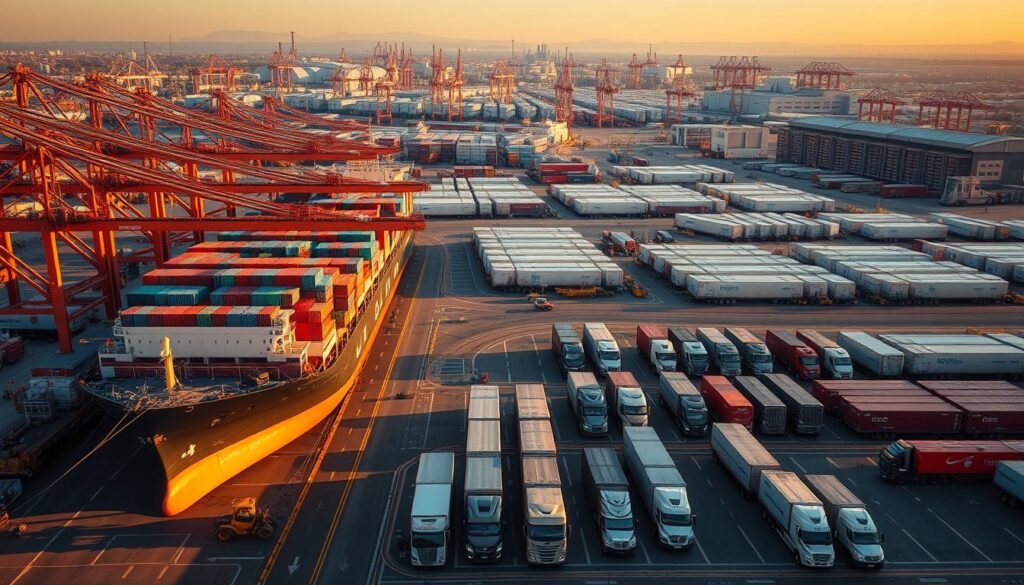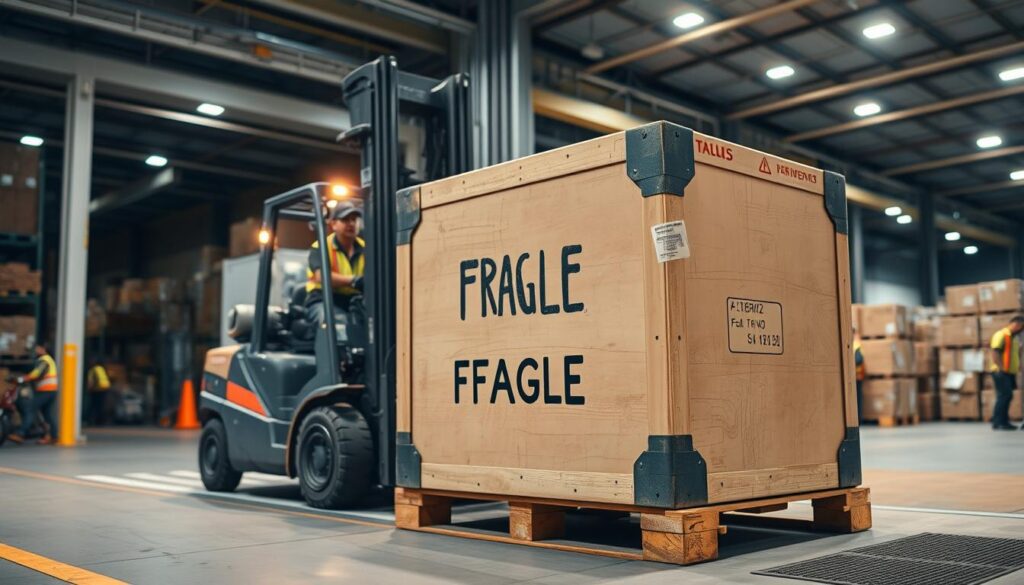Need to ship heavy package to a friend, family member, or customer? You’re not alone. Figuring out how to ship a heavy item safely and affordably can be challenging, especially with size restrictions and shipping costs to consider.
Shipping heavy packages involves several challenges, including adhering to weight and size restrictions. This guide is designed to walk you through the process, providing step-by-step instructions and valuable insights to simplify your shipping experience.
Key Takeaways
- Understand the challenges of shipping large items
- Learn how to ensure safe handling and manage costs
- Discover the importance of adhering to weight and size restrictions
- Get step-by-step instructions for shipping heavy items
- Gain valuable insights to simplify your shipping experience
The Challenges of Shipping Heavy Packages
You may encounter numerous challenges when attempting to ship heavy or oversized packages. Shipping such items requires careful planning and consideration of various factors to ensure safe and cost-effective delivery.
Common Weight and Size Restrictions
One of the primary challenges is navigating the weight limit for shipping imposed by carriers. Exceeding these limits can result in additional costs or even the refusal of shipment. For instance, most carriers have specific guidelines for oversized packages, which may require special handling and freight shipping services.
Handling and Safety Concerns
Heavy packages pose significant handling and safety risks. Improper handling can lead to damage to the item, injury to personnel, or both. It’s crucial to use appropriate packaging materials and techniques to mitigate these risks and ensure the safe transportation of heavy items.
Cost Factors That Affect Heavy Shipments
The cost of shipping heavy packages can be substantial, influenced by factors such as the package’s weight, size, and destination. Understanding these cost factors, including the potential need for specialized freight services, can help you plan and budget more effectively for oversized package delivery.
By understanding these challenges, you can better prepare yourself for the complexities involved in shipping heavy packages, ultimately making the process more manageable and cost-effective.
How to Prepare to Ship Heavy Package Successfully
Preparing to ship heavy packages involves several key steps that can make all the difference between a successful delivery and a costly mistake.
Accurate Measuring and Weighing Techniques
To ensure accurate shipping costs and prevent delays, it’s essential to measure and weigh your packages correctly. Use a reliable scale and measuring tape to record the length, width, and height of your package. This information will help you determine the correct shipping category and avoid any potential surcharges.
Essential Materials Checklist
Having the right packaging materials is crucial for safe and secure shipping. Make a checklist of the materials you’ll need, including heavy-duty boxes, packing paper, bubble wrap, and tape. Ensure that your materials are suitable for the type of items you’re shipping and can withstand the rigors of transport.
Creating a Shipping Timeline
Creating a shipping timeline helps you plan and organize your large parcel shipping process. Consider the delivery deadline, transit times, and any potential delays. By scheduling your shipments in advance, you can ensure that your packages arrive on time.
Scheduling Pickup Services
If you’re shipping heavy or bulky items, consider scheduling a pickup service with your carrier. This can save you time and effort, as the carrier will come to your location to collect the package. Be sure to check the carrier’s pickup schedule and requirements in advance.
Planning for Dropoff at Carrier Locations
If you prefer to drop off your packages at a carrier location, plan ahead to ensure a smooth process. Check the carrier’s location, hours of operation, and any specific requirements for heavy or bulky packages. By doing so, you can avoid any last-minute issues or delays, especially when shipping heavy items overseas.
Selecting the Right Packaging for Heavy Items
Protecting your heavy shipments starts with selecting the appropriate packaging materials and techniques. The right packaging is critical for ensuring that your heavy items arrive at their destination safely and undamaged.
Heavy-Duty Boxes and Crates Options
For heavy items, you’ll need packaging that can withstand the weight and potential impacts during shipping. Heavy-duty boxes and crates are designed for this purpose. They are made from robust materials that can handle heavy loads without collapsing.
Industrial-Strength Cushioning Materials
Cushioning is essential for absorbing shocks and preventing damage to your heavy items. Industrial-strength cushioning materials such as foam inserts, bubble wrap, and packing peanuts can be used to protect your shipments.
Reinforcement Techniques for Added Protection
To further protect your heavy packages, consider using reinforcement techniques. This includes using corner protectors and edge guards to safeguard against impacts and abrasions.
Corner Protectors and Edge Guards
Corner protectors and edge guards are specifically designed to protect the most vulnerable parts of your packages. They absorb impacts and prevent damage to the items inside.
Strapping and Banding Methods
Strapping and banding are effective methods for securing heavy packages. They help to keep the packaging materials in place and prevent the package from opening during transit. Use industrial-grade straps and banding materials for maximum security.
By choosing the right packaging materials and techniques, you can ensure that your heavy items are well-protected during shipping. This not only reduces the risk of damage but also helps to maintain customer satisfaction.
Step-by-Step Packaging Guide for Oversized Items
To ensure your large parcels reach their destination undamaged, follow these step-by-step packaging guidelines. Proper packaging techniques are essential for safe and efficient shipping, especially when dealing with bulky or heavy items.
Disassembling Large Items for Easier Shipping
When possible, disassembling large items can make them easier to package and transport. This step can help reduce the risk of damage during shipping. Always refer to the manufacturer’s instructions for guidance on how to disassemble the item safely.
Wrapping and Protecting Fragile Components
Wrap fragile components carefully using industrial-strength cushioning materials. Bubble wrap, foam inserts, or paper padding can be used to protect vulnerable parts. Ensure that all wrapped components are secure and won’t shift during transit.
Proper Weight Distribution Inside Packages
Balancing the weight evenly inside the package is crucial. Place heavier items at the bottom and ensure that the weight is distributed to prevent the package from tilting or becoming unstable. This helps in maintaining the package’s integrity during shipping.
Sealing, Labeling, and Marking Heavy Packages
Seal packages securely using heavy-duty tape, and reinforce seams and edges for added protection. Proper labeling is also critical; ensure that shipping labels are clear and securely attached to the package.
Required Warning Labels
Use warning labels to indicate if a package contains fragile items or is overweight. Examples include “Fragile,” “Handle with Care,” and “This Side Up” labels. These warnings alert handlers to take extra precautions.
Directional Markings
Directional markings, such as arrows indicating the correct orientation of the package, are essential. This helps handlers understand how to handle the package correctly, reducing the risk of damage.
- Use clear and visible labels.
- Ensure labels are securely attached.
- Follow carrier guidelines for labeling.
By following these steps, you can ensure that your bulky packages are shipped safely and efficiently, reducing the risk of damage and additional costs associated with large parcel shipping and bulky package transport.
Comparing Major Carriers for Heavy Item Shipping
Shipping heavy items can be a complex task, but comparing carrier services can simplify the process. When you’re shipping heavy items, selecting the right carrier is crucial for ensuring your packages reach their destination safely and efficiently.
USPS Parcel Select and Priority Mail Heavy Options
The United States Postal Service (USPS) offers several options for shipping heavy items, including Parcel Select and Priority Mail. Parcel Select is ideal for heavy or bulky items, providing a cost-effective solution for shipping to businesses and individuals. Priority Mail, on the other hand, offers fast and reliable service, with options for heavy packages up to 70 lbs.
UPS and FedEx Heavy Package Services
UPS and FedEx are renowned for their comprehensive shipping services, including options for heavy packages. UPS offers services like UPS Ground and UPS Freight, catering to heavy and oversized shipments. FedEx provides similar services, including FedEx Ground and FedEx Freight, with a focus on reliability and speed.
Regional Carriers for Specialized Needs
For specialized or regional shipping needs, consider using regional carriers. These carriers often provide tailored services that cater to specific geographic areas or types of shipments, offering competitive pricing and personalized service.
Weight Limits Comparison Chart
Here’s a comparison chart to help you understand the weight limits of major carriers:
| Carrier | Maximum Weight Limit |
|---|---|
| USPS Parcel Select | 70 lbs |
| UPS Ground | 150 lbs |
| FedEx Ground | 150 lbs |
| Regional Carriers | Varies |
When shipping heavy items overseas, it’s essential to consider carriers that offer international freight shipping services. Services like UPS and FedEx provide comprehensive global shipping solutions, while USPS offers competitive rates for international shipments.
Understanding Freight Shipping Services
Freight shipping services are designed to handle heavy or oversized packages that standard shipping methods can’t accommodate. When you’re dealing with large or heavy items, understanding your freight shipping options is crucial for ensuring that your packages reach their destinations efficiently and safely.
Freight shipping is a broad term that encompasses various services tailored to different needs. To make informed decisions, you need to be aware of the different types of freight shipping services available.
Less Than Truckload (LTL) vs. Full Truckload (FTL)
The two primary categories of freight shipping are Less Than Truckload (LTL) and Full Truckload (FTL). LTL shipping is ideal for shipments that don’t require a full truck. It’s cost-effective because you only pay for the space your cargo occupies. On the other hand, FTL shipping is used when you have a large quantity of goods that need to fill an entire truck. FTL shipping can be faster since it involves less handling and no consolidation with other shipments.
- LTL is suitable for smaller shipments, offering flexibility and cost savings.
- FTL is better for larger shipments, providing dedicated truck space and potentially faster transit times.
Freight Classes and National Motor Freight Classification
Freight is categorized into different classes based on the National Motor Freight Classification (NMFC) system. This classification considers factors like density, handling, liability, and stowability to determine shipping costs. Understanding your shipment’s freight class is essential for accurate pricing and to ensure compliance with carrier requirements.
For instance, items that are heavy, durable, and easy to handle are typically classified lower, resulting in lower shipping costs. Conversely, items that are fragile, hazardous, or difficult to handle are classified higher, increasing shipping costs.

Terminal-to-Terminal vs. Door-to-Door Delivery
Freight shipping services offer different delivery options to suit various needs. Terminal-to-terminal delivery requires you to drop off and pick up your shipment at designated terminals. This option can be more cost-effective but requires more effort from you.
In contrast, door-to-door delivery provides a more convenient service where the carrier handles the shipment from your doorstep to the recipient’s. While more convenient, this option may incur additional costs.
Lift Gate and Inside Delivery Services
Additional services like lift gate and inside delivery can be crucial for shipments that require special handling. A lift gate service allows for the loading and unloading of freight at locations without a dock, using a hydraulic lift gate on the truck.
Inside delivery takes the shipment beyond the delivery truck, into your home or office, which is particularly useful for large or heavy items, or fragile packages that need extra care during delivery to prevent breakage or mishandling.
By understanding these aspects of freight shipping services, you can make informed decisions that best suit your shipping needs, ensuring that your heavy or bulky items are delivered safely and efficiently.
Cost-Saving Strategies for Bulky Package Transport
Large parcel shipping doesn’t have to break the bank if you employ the right strategies. Shipping bulky packages can be costly, but by understanding your options and planning carefully, you can significantly reduce your expenses.
Rate Shopping Across Multiple Carriers
One of the most effective ways to save on bulky package transport is to compare rates across multiple carriers. Different carriers offer different pricing structures, and some may be more competitive for your specific shipping needs.
For instance, you might find that USPS Parcel Select is more economical for large parcels, while UPS or FedEx might offer better rates for expedited shipping. Using a shipping comparison tool like Parcel Monkey can simplify this process by allowing you to view and compare prices from various carriers in one place
Negotiating Volume Discounts
If you ship bulky packages frequently, negotiating volume discounts with carriers can lead to substantial savings. Carriers often offer discounts to high-volume shippers as a way to secure their business.
To negotiate effectively, you should have a clear understanding of your shipping volume and be prepared to discuss your needs with the carrier. Building a strong relationship with your carrier can also be beneficial.
Dimensional Weight vs. Actual Weight Considerations
Understanding the difference between dimensional weight and actual weight is crucial for saving on shipping costs. Carriers charge based on the greater of the two: the actual weight of the package or its dimensional weight (which reflects the package’s density).
For bulky but lightweight packages, dimensional weight can significantly impact shipping costs. Optimizing packaging to reduce dimensional weight can lead to cost savings.
Timing Shipments to Avoid Peak Surcharges
Shipping during peak periods, such as holidays or special events, can incur additional surcharges. Planning your shipments around these peak times can help you avoid these extra costs.
| Carrier | Standard Rate | Peak Surcharge | Total Peak Rate |
|---|---|---|---|
| USPS | $100 | $20 | $120 |
| UPS | $110 | $25 | $135 |
| FedEx | $105 | $22 | $127 |
By implementing these cost-saving strategies, you can significantly reduce your expenses on bulky package transport. Whether it’s through rate shopping, negotiating discounts, optimizing packaging, or timing your shipments wisely, there are multiple ways to make your large parcel shipping more cost-effective.
Insurance, Tracking, and Delivery Confirmation
To ship heavy packages with confidence, you need to consider insurance and tracking. Ensuring the safe delivery of heavy items involves more than just packaging and shipping; it also requires adequate insurance coverage and tracking.

Insurance Options for High-Value Heavy Items
When shipping high-value heavy items, it’s essential to consider insurance options that protect your investment. Many carriers offer insurance coverage for an additional fee, which can provide financial protection against loss or damage. You should carefully review the insurance options and terms offered by different carriers to determine the best coverage for your needs.
Key factors to consider when selecting insurance include the value of the item, the shipping distance, and the carrier’s reputation for handling claims.
Advanced Tracking Technologies
Advanced tracking technologies play a crucial role in monitoring the shipment of heavy packages. Carriers utilize various tracking systems, including GPS and barcode scanning, to provide real-time updates on the package’s location and status. This allows you to stay informed throughout the shipping process and take proactive measures if any issues arise.
As noted by a shipping expert, “Tracking is not just about knowing where your package is; it’s about ensuring it reaches its destination safely and on time.”
Delivery Appointment Scheduling
For heavy or bulky items, delivery appointment scheduling is often necessary to ensure that the package is received by the intended recipient. This involves coordinating with the carrier to schedule a delivery time that works for both parties. By doing so, you can avoid missed deliveries and ensure a smooth delivery process.
- Coordinate with the recipient to schedule a delivery time.
- Provide the carrier with detailed delivery instructions.
- Track the package to ensure it arrives on schedule.
Claims Process for Damaged Heavy Shipments
In the event that a heavy shipment is damaged during transit, it’s crucial to understand the claims process. Most carriers have a formal process for filing claims, which typically involves providing documentation of the damage and proof of the item’s value. To facilitate a smooth claims process, keep detailed records of your shipment, including photos of the packaging and contents before shipping.
To file a claim successfully, follow the carrier’s instructions carefully and provide all required documentation promptly.
Conclusion: Shipping Heavy Items with Confidence
Shipping heavy items can be a complex task, but with the right strategies, you can ensure that your large parcels are delivered safely and efficiently. Whether you’re shipping heavy items overseas or within the United States, careful planning is crucial. This involves accurately measuring and weighing your packages, selecting the appropriate packaging materials, and choosing the right shipping carrier.
By understanding the different shipping options available, including USPS, UPS, and FedEx, you can make informed decisions that meet your needs for large parcel shipping. Additionally, considering factors such as freight classes, dimensional weight, and insurance options can help you navigate the process with confidence.
Ultimately, shipping heavy items requires attention to detail and a thorough understanding of the shipping process. By following the guidelines outlined in this article, you can ensure that your heavy items are shipped efficiently, safely, and on time, whether domestically or internationally, including shipping heavy items overseas.

